Axiom, Idiom, Maxim: Proposals for Queer Critique
Queering the normative expectations about what criticism is, what it should do, and who it is for
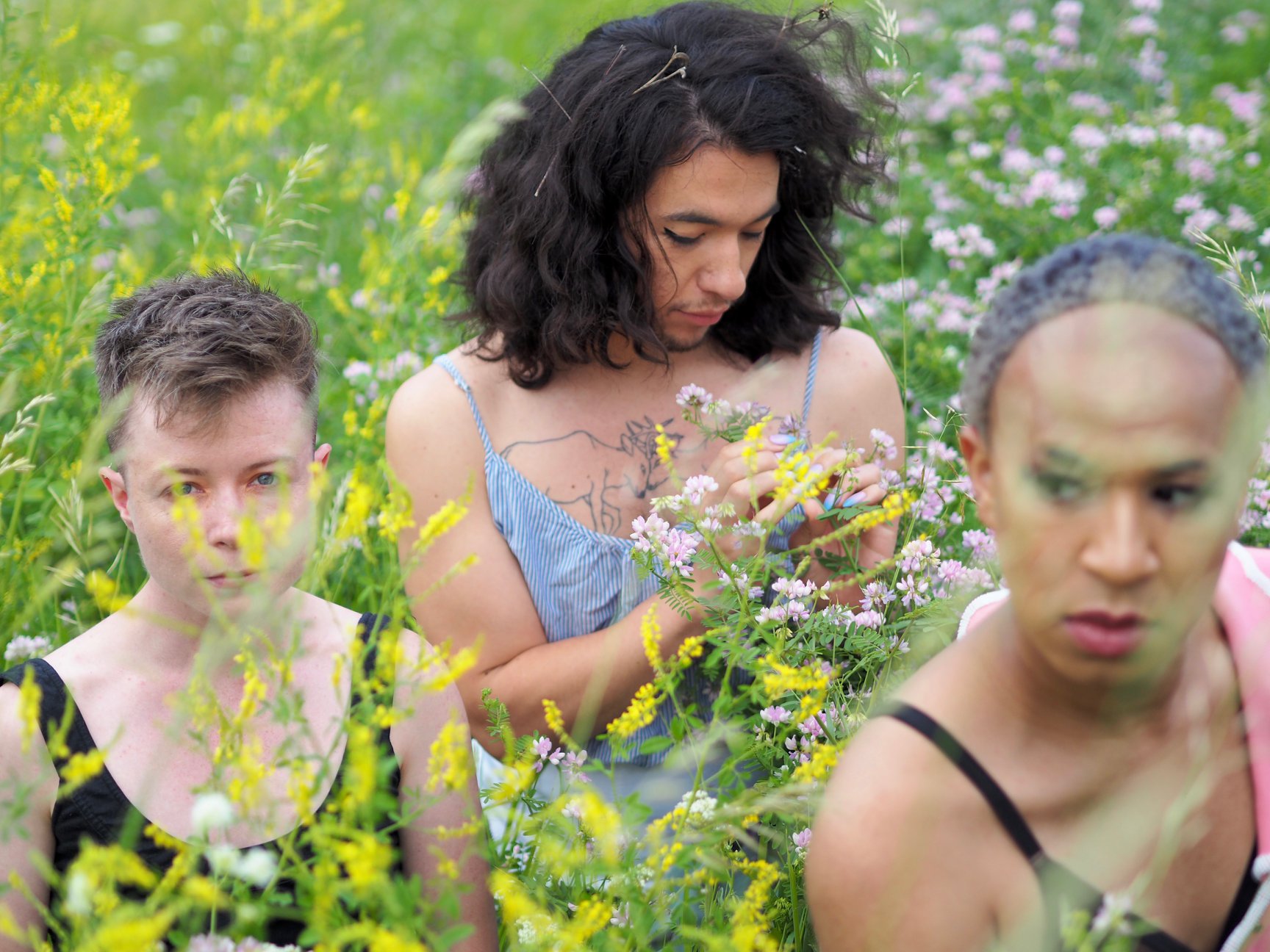
INTRODUCTIONCollaborative decision-making is key for Lightning Rod, not only for our artistic endeavors, but in our administrative structure. A trans-led arts organization based in Minneapolis, MN/Dakota land, Lightning Rod’s work is guided by a desire to foster legacy, development, and opportunity for QTGNC artists and activists. What follows is a conversation that proposes a way of delivering group feedback in experimental art spaces. We believe this methodology builds on the critique structures we have experienced in the past by centering brevity and depth while queering the normative expectations about what criticism is, what it should do, and who it is for.
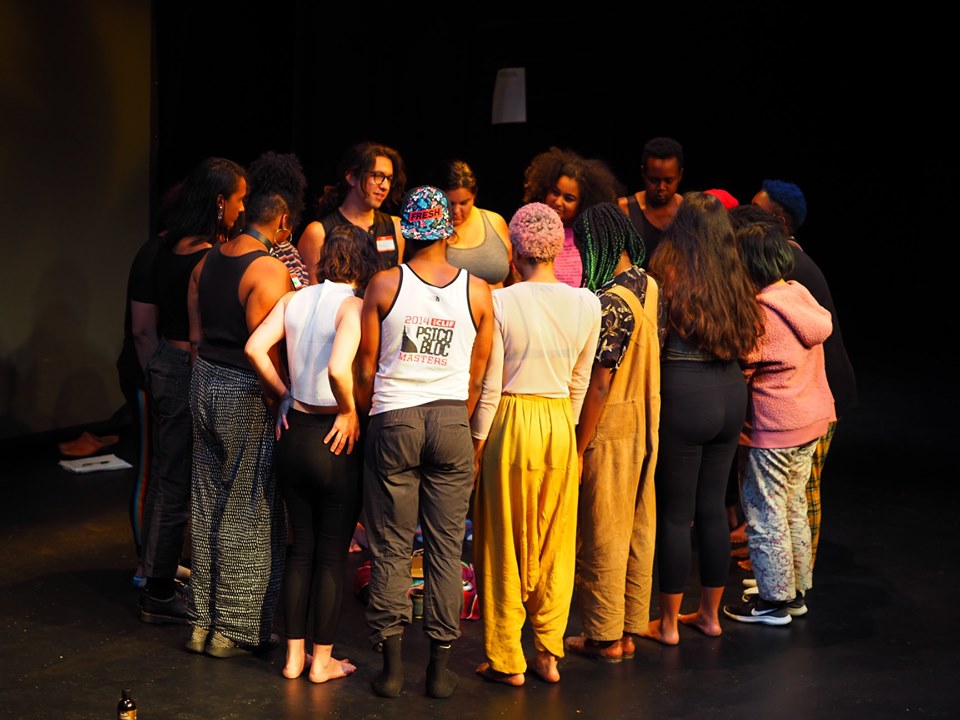
Photo: Jenny Zander. 
Photo: Jenny Zander. 
Photo: Jenny Zander.
AGAINST SOFT CRITICISM
MARCELA MICHELLEI feel a desire for criticism, for more direct criticism. I’m already in a practice of working towards that with my peers and my frequent collaborators, but it’s harder when I’m getting feedback in a formal setting. In formal settings, there’s a trend towards vagueness, or making things subjective and qualifying. What I want someone to say is, “That was bad.” What I want to hear is, “That was so stupid.” I have taken lately to being flippant with saying, “That’s stupid. That’s bad. I don’t like that.” And I do want more of that. First of all, don’t come for me when I say “stupid.” I’m not talking about your IQ or any other white metric of intelligence. I’m saying, “Don’t be stupid.” If you’re trying to come for me, that feels stupid.
yoni tamangThere’s a relation of this kind of criticism to true experimentalism and what it would mean to be in a space where it’s safer to say something that’s wrong, to say something and take it back, to be held enough to have that freedom.
MMI’ve also been told that this wave of using soft criticism is for me, that it’s the result of years of white men being too mean. Soft criticism to me sometimes feels like a pronoun circle where I’m the only trans person in the room and I don’t want to tell you my pronouns, but I need to listen to other people talk about their pronouns…and this is for me?
KPThere’s an assumption that honesty is an intimate act, an assumption that the other person can’t handle your honesty. That assumption is inherent in soft feedback. Sometimes there’s the assumption that one is the wrong person to give feedback. So, instead of saying, “I am the wrong person to give feedback,” they give you this vague, open-ended word salad about what they saw.
I recently had someone email me a video of their choreographic process and ask me for feedback. I really appreciated the direct ask, the opportunity to just name my bias, what I think, what I think would work for this person, what I don’t think would work for this person and being honest about the quality of their work, and what I believe they can and cannot achieve in the time that they have. That felt very good.
YTTo be honest presupposes access to one’s own intuition about a work of art. Many times, when one receives softer feedback that isn’t helpful, the person providing the feedback is not sure what’s happening inside of themselves either. I see that a lot, especially in the experimental art space. When you’re seeing something indescribable how are you “supposed” to feel?
MMWe’re talking about anxiety, right? Anxiety around honesty, anxiety around looking stupid in the more traditional sense of looking like you’re not cool, or in the know or weird enough.
KPAnxiety that you don’t have anything to contribute or that you don’t belong in this circle.
MMBut someone in the room with more power than you—cooler than you, older than you, younger than you, whiter than you, Blacker than you—who is going to think you’re wrong, and that’s associated with that too. As Ricardo Beaird says, “Loud and wrong.”
KPI love that.
MMThat’s what I want. I would rather know that you think this and disagree than leave wondering what you thought. If I’m in a feedback session, that’s a fair thing to ask for.

Photo: Nathan Dale. 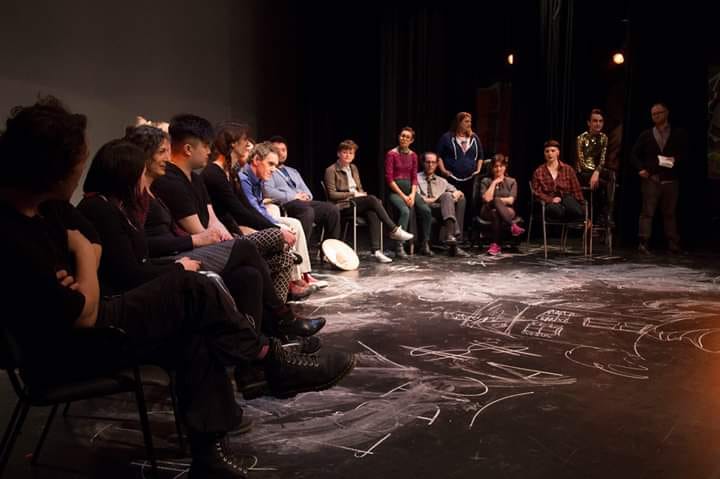
Photo: Ari Newman. 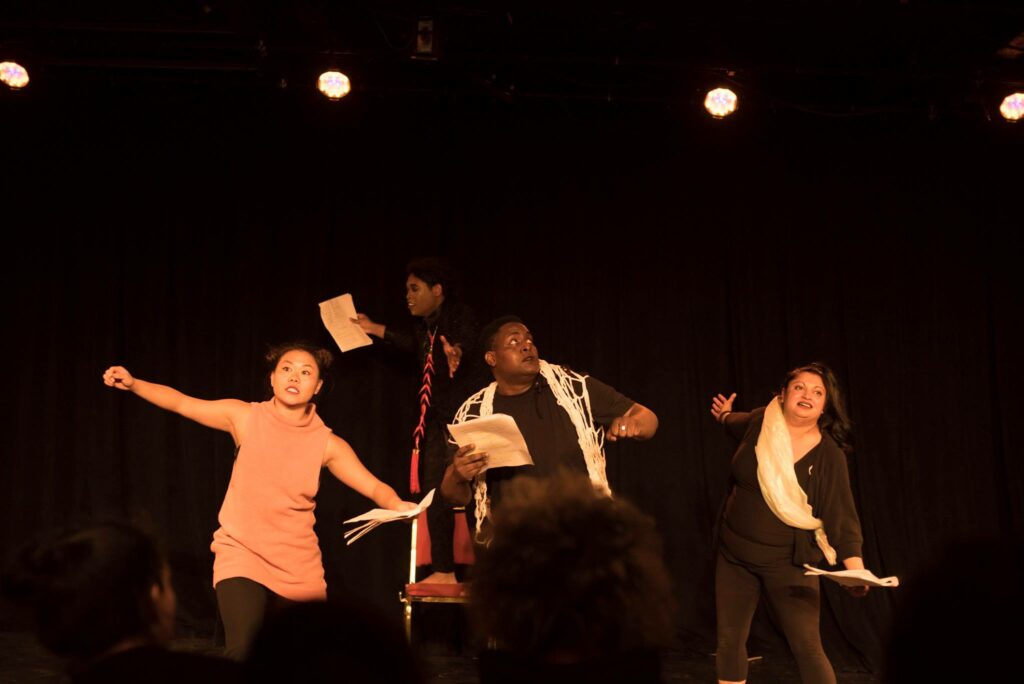
Photo: Ari Newman.
AXIOM, IDIOM, MAXIM
MMPart of why I am so into Axiom, Idiom, Maxim as a protocol for feedback is because it is simultaneously interpretive. There are multiple steps. It forces pithiness. Even if what I’m not getting is direct, sharp-pointed feedback—within your axiom, idiom or maxim—there is something sharp and pointed for me to chew on.
KPIt’s an encouragement to make an assertion of any kind.
MMYou can also say, “Of the scene where the two of you were arguing, where you were at the table: better to keep what you have than to get what you want.” Or, you could say, “That line, that one line, ‘Her Eyes Were Watching God’: we eat with the eyes first.” So, you can either be very specific about one gesture, moment, line, look, or you can say, “The show overall…”
YTThere’s an element of camp in it as well.
MMBecause you can make it a read, one that is supportive, tender.
KPIt can be a celebration. I feel mischievous when I make an axiom/idiom/maxim for feedback. And I feel less lonely when I get this type of critique.
MMAs a maker?
KPYes. I feel less lonely in the little worlds that got created for this one step of the artwork. I’m just in phase one or draft two or whatever…and a little terrarium got made and I’m inside it. Meaning I have created a tiny, nutrient-rich environment, with clear limitations, to grow things inside of. I feel very lonely sometimes when I’m in that terrarium of the work, and when I receive critique, I feel like somebody is either in the terrarium or at least tapping on the glass. It also affirms that the terrarium exists, that the work exists. That it’s not an invisible musing or raving.
YTThere’s an element of Axiom, Idiom, Maxim that is like pulling tarot cards, to have a symbolic system that helps the artist reflect what they already know to be true about the work of art.
MMMuch is revealed in the search for a metaphor.
YTThere’s something freeing in not having to justify an opinion.
MM & KPYes.
YTSometimes, when delivering feedback, one might cite their own subjective experience of the work of art as evidence to support their criticism of it, which makes no sense to me. Your experience of the thing was subjective.
MMIt’s redundant. Like, honey, we know. That’s the thing.
YTThe formula for this type of feedback goes something like: “I thought I thought the thing was bad because I thought, ‘It’s bad.’” Just say “It’s bad.”
MMWhen we talk about Axiom, Idiom, Maxim, what we’re talking about is a feedback protocol—invented perhaps by Marcela Michelle; if it was invented by someone else then you can sue me, but it was new to me—and it means that your feedback has to come in the form of an axiom, an idiom, or a maxim. I love to hear one of each.
An axiom is an established proposition, an assumption, a postulate. It’s from the Greek “axioma,” or that which is worthy or commends itself as evident. I would say that an axiom is, “Trans women are women,” and “All men are created equal.” So, for me it means retention, because neither of those are just true—or both warrant some teasing out. (Laughs.) I want someone to fight me.
An idiom is a group of words established by usage as having a meaning not deducible from those of the individual words. e.g., “It’s raining cats and dogs,” or “like clockwork.” This is a pretty broad definition too, because there are idioms that intuitively make sense due to our familiarity with them in our culture, but then there are ones that are, for me, more bizarre—such as “to give one’s eye teeth,” meaning to go to any lengths to obtain. As in, “She’d give her eye teeth for a mink coat.” It’s similar to, “He’d give his right arm for a new car.”
(Reading.) “These hyperbolic expressions both allude to something precious—‘eye teeth’ or canines, being useful for both biting and chewing—and the right arm, a virtual necessity for 90 percent of the population who are right-handed.”
And there’s so much there, so much to tease out.
KPI love hyperbole so much.
MMDitto.
A maxim is a short, pithy statement expressing a general truth or rule of conduct, e.g., “Actions speak louder than words.”
And then there are statements that hit all three or live nebulously. One of my favorites is, “Chickens always come home to roost.” Which I only say as a threat.
YTIt feels like a threat.
MMI say it as a curse.
KPI wonder if that is the formula for a curse, to have all three—an axiom, an idiom, a maxim—in one statement. The grimoire of Lightning Rod should contain this formula for a spell.
MMMaybe, maybe it is. But, “Chickens always come home to roost” can be a good thing. Right? We just have only ever heard it in a foreboding sense.
YTSo context matters.
MMContext matters; tone matters; the person saying it to you matters. There’s something inherently queer about it. There’s something that tickles the Bette Midler fan in me about the idea that it’s campy, that it’s witty, that it can be a read, that it can be like a curse.
(Long pause.)
YTCampiness deflates the severity of a talkback or a critique and reinflates it with hot air, but it’s still a way of accessing truth.
MMI would rather hear, “Done spaghetti will stick to the wall.” That to me says more to me than, “I was wondering about the use of costume.”
(Yoni laughs.)
KPI like that it’s a game. That means that the stakes can be as high or as low as you like. And it also means that it can be something that you can invite laypersons into – to a certain extent – a wide scope of humans, of intellectual and aesthetic proclivity.
MMDifferent cultures have their own axioms, idioms, and maxims, right? That’s exciting to me because it feels like this feedback protocol could open up space where cultural exchange is possible. If we at Lightning Rod are saying that this feedback protocol is an inherently queer way of engaging, or that we like the queer mechanisms of it, then I like the idea of it being the standard for our company. Because that means if we’re in another space, we can invite people into this protocol. We’re saying that in our vagabond state, we brought this queerness with us, and if you want to engage with me, you have to engage with this thing that we’ve developed over here.
YTThis bit.
MM(Laughs.) Yeah, this bit that a bunch of trannies made up in a kitchen. You have to do it.
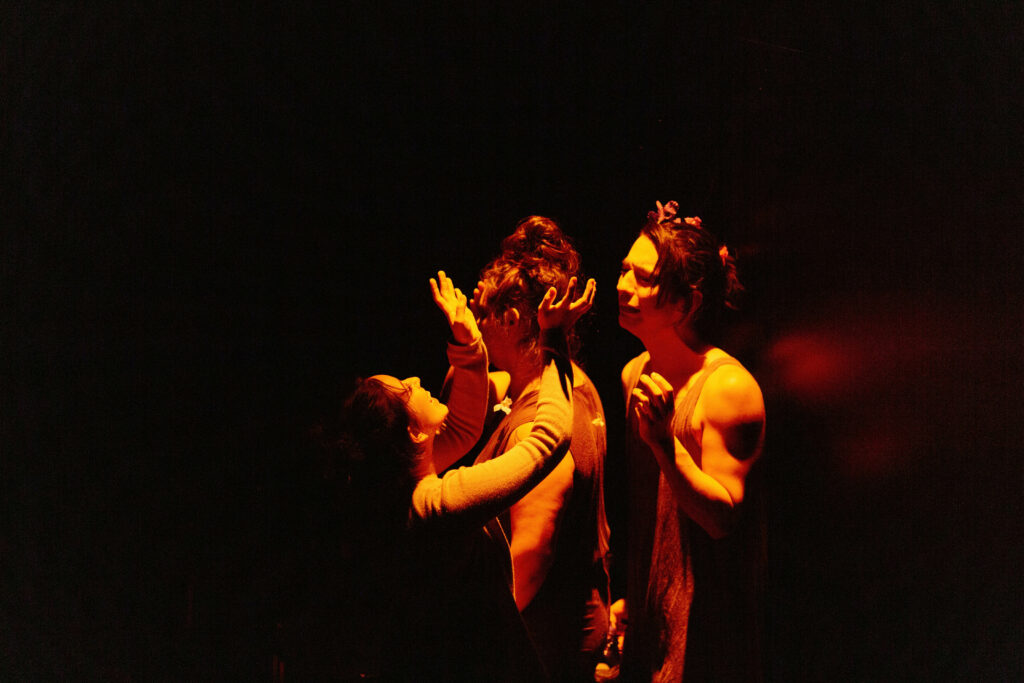
Photo: Nathan Dale. 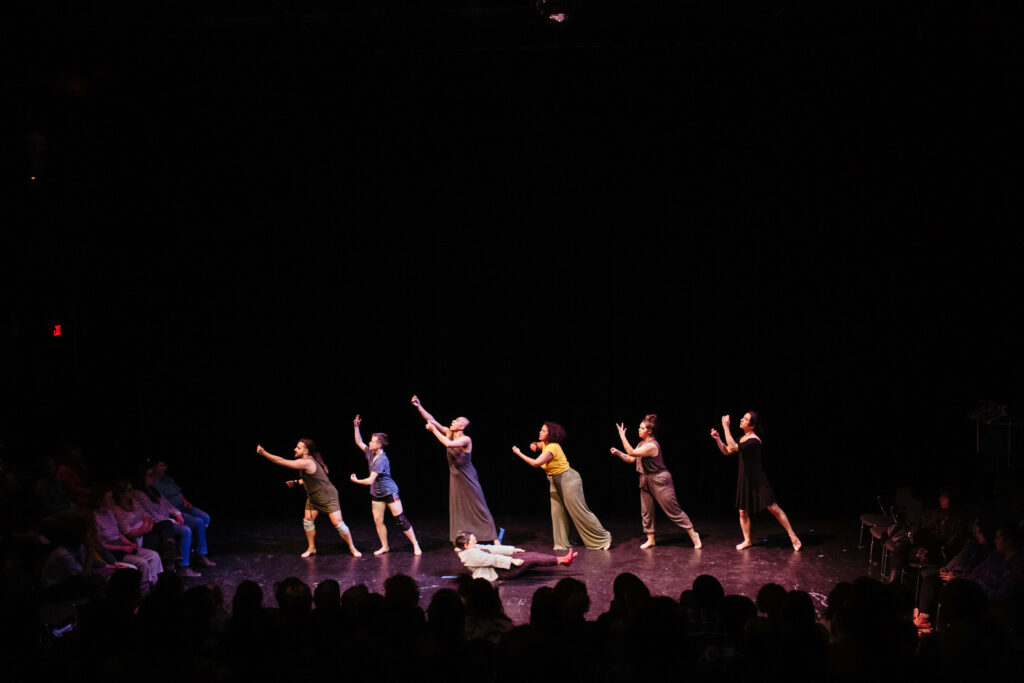
Photo: Nathan Dale. 
Photo: Nathan Dale.
CRITICISM IN COLLECTIVE
KPWhat goes into the development of critical practice? I think we can formulate that for ourselves. What does it mean to disseminate such a practice? We have spoken in the past of a desire to influence the culture around criticism, to encourage more of it, but a very specific type of criticism.
MMRachel Cusk is an English author who wrote a book called Coventry that I’ve been listening to. She talks about this English idiom of sending one to Coventry, which is a city, but also like an idea of a place where naughty children are “sent to,” akin to what we might call the “dog pound.” She states that “coventry” is not just the literal place, a city in England where people send children, but also a concept, akin to what we might call “the dog pound.” It’s a form of exile. What speaks to me, and what seems relevant to conversation here, is when she describes the concept of coventry as a folie à deux, as a mutual happening. In order for me to be excommunicated—in order for me to be sent to coventry—we both have to believe in it. We both have to commit to this bit.
I want to apply Cusk’s idea of suspension of disbelief to what we’re working towards here in Axiom, Idiom, Maxim. The idea of “trust the audience”—what it’s always been like for me when I’ve been told it—is that what you’re doing isn’t too smart for them; don’t think that it’s over their heads. If you trust them with your work, they’ll get it. They’ll rise to the occasion. Trust that they’ll go with you, and don’t get so caught up in, “Does it look real?” I’m wondering where there’s room for that mutual suspension of disbelief in criticism, and I’m wondering where there is space for that to move towards folie à deux.
KPI think suspension already exists in criticism because there is an assumption of expertise. There will be people who offer critique who will be believed no matter what. It may or may not be a mutual or level understanding, but it is a suspension of disbelief.
MMPoint-counterpoint: Yoni said the opposite thing earlier, that there’s this need to presuppose/justify one’s opinion, which to me belies an assumption of inexpertise.
KPBoth are true. I think it depends on where the critique is published or shared.
MMThank you for saying that because I have been thinking about feedback delivered in a room, in literal feedback sessions.
The other thing that I was saying earlier is, “You don’t know how to read what I’m doing.” I’m thinking of course about that much-maligned critique that was written about a trans dancer in town who was in a dance showcase. At the time I claimed that it was less interesting because we need trans critics who are of color, specifically Black trans critics. There’s that solution, but I would also like to live in a world where everyone can critique everyone’s work. Which I think is a little bit of the, “Let’s not do all of this justifying, that I’m not an expert on your experience because I don’t share these identities or this experience.”
When Scarlett Johansson says, “I should be able to play any man, any tree, any transgender,” I think, “Yes, I wish we lived in a world where that was true, baby, and unfortunately it’s people like you who prevent it from happening.” I feel that way about criticism too. I don’t only want to be critiqued by Black trans people. I don’t only want to be critiqued by other Indigenous people. I want to hear what people think about my work. I respect and admire a lot of different people—white people, cis people. But if your critique belies an ignorance or inability to look at me, then we have a problem. I don’t think it’s true that you can’t see me inherently if we do not share an identity vector. I reject that notion.
YTThere’s a politic inherent in what you’re saying, in the way that we at Lightning Rod are interested in reprogramming the affects—or underlying experiences of feeling, emotion, or mood —of being in collaboration. The neoliberal affect of collaboration is the Scarlett Johansson approach, where everyone gets along, it’s nice all the time, and everyone likes each other’s work. That is the lie. The actual affects of collaboration are much rockier, including “That was stupid.” There’s shock and disagreement. It’s not always consensus and hand-holding.
MMI feel like I have been in feedback protocols where the soft method that was presented to shield white people from hearing that what they were doing was violent.
YTAbsolutely.
MMThere was no room for me in the feedback protocol to say, “I’m the only Black person in this room, and what’s happening is awful, awful, awful.” I don’t get to say that because it’s not framed nicely. Fuck that. I’m still mad.
The intimacy is the politic.
It’s interesting to me that I’ve been in rooms where people have told me about their sexual abuse, about their parents dying, horrible breakups. They told me about crossing oceans to come be here, about fleeing massive violence in their country, but they can’t say, “I didn’t like that. That was bad.” “I can see that you’re trying to do five, six, seven, eight, and you were off.” Why can you show me your naked body, why can you flagellate yourself in front of me, but you can’t tell me, “You’re going too fast”?
YTWell, many of us can relate to that moment when we were told that something we did was bad, and our first reaction was to kill the dream of ever doing it again.
KPIt’s so funny because I am about to meet with a teacher—a pedagogical director—who was more in the lineage of, “That’s good,” or, “That’s bad”—and wanted to counter what was good and what was bad. It was rigored and it was good to a certain extent, because what he was encouraging us to do was to be disciplined in our technique. What was unfortunate was that his subjectivity was never acknowledged, that he wanted us to believe his expertise was divine or that he was objectively right all the time. The other teacher was the exact opposite. She was not hippy-dippy about it; she was incredibly smart, but was always giving feedback in the form of questions. The rigor that she asked for was that you would be able to answer questions about your work and be able to be specific. She never set out to judge anyone’s work, but she did set out to ask people to be able to make strong choices, explain their choices, and justify their choices. I like the juxtaposition of these two different kinds of critical processes.
MMHearing that, I do qualify my feedback with, “Do with this what you will.” I say that all the time. I don’t care if you take my feedback. It does not bother me; it is your show, honey. We’re in this room together for a reason. Whether you asked for my opinion or not, if we’re in this room because we were brought together by a company and we’re in a thing together—I’m here; you’re here. I’m going to hear your feedback. I want to make the most of it. I’m going to give you mine and I’m going to give you it strong.
KPI think that effective critique is an opening and an offering. Sometimes people don’t know that we have heard critique which either has been received as a restriction—an unfair restriction—or sometimes it actually was an unfair restriction. Maybe we need to get better at telling people what kind of critique we want, and asking people what kind of critique they want. And if we did that as a regular practice over time with trusted collaborators, we could start to train ourselves out of letting our traumas inform the way we receive feedback.
MMI think that there’s a thing that happens in feedback: sometimes a dominant party learns that they’ve been oppressive so they take steps to change their behavior and they don’t realize that the new protocols they’re making still center what they need to rectify. Because Black people don’t need to learn to speak softer and less, so if everyone’s white and they say, “Let’s make these soft, nice critiques because for too long white men have been the objective voice of God,” well, that’s fine for you, honey, but I don’t want to do that. I don’t have to pay for your sins.
KPI think space is opened when one gives straightforward, honest critique—in all the ways that we’ve been talking about—honesty, intimacy, being to the point, and getting rid of qualifiers. It opens up the opportunity for other people to do the same. People catch on really quick.
YTThe urge to be precious in criticism has to be rooted in capitalism. Right? Because if you believe the fiction that the value of the work of art is inherent in the object of art, then you’re going to want to be really gentle with it. Otherwise, you won’t sell tickets.
KPThat’s so real. I think critique is an attempt to keep an artwork alive. That is my response to your comment about capitalism. It could go either way. Critique could be a practice that ensures an artwork’s ability to shift and breathe, to be part of a living culture. Or as a way of extending its ability to be appraised for cash into perpetuity. I have done the bartending at the cocktail party for the fellowship of the upcoming curators who just came back from their residency in Milan. And I am this ornamental queer working class artist serving prosecco on the patio, and I’m listening to these people talk about travel, and names, and galleries. But I didn’t hear anything at all about art. And the only thing I heard about culture was like, the sound of cash registers coming out of the mouths of these Manhattan cishets in khaki shorts.
YTAxiom, Idiom, Maxim also demands a certain level of rigor from people who are used to having to only foster a relationship with their own experience. That’s easy. If you can’t do that, like, figure it out on your own time.
MMPeople ask me, “What is reading?” Because, you know, the terms “shade” and “reading” and “tea” have all taken up multiple meanings. What Dorian Corey says in Paris Is Burning is: “Well, shade came from reading and reading was how you got the girls right. But it’s an art form. It’s clever banter to tell you about yourself and you’re going to come back and if I read you about your brows last night, you’re going to go home and you’re going to work on them because you know you’re going to get read.”
And that is what criticism should be. I think criticism should be information about yourself for you to do something with. If you have a vision, stick by your vision. If everyone reads you about your eyebrows, and you are like, “No, honey. This is the future.” Stick with it! You’ll know because you either won’t get booked ever or you won’t get booked for a while, and then you’re going to be the shit that everyone’s talking about because you were right.
KPWe’ve witnessed that so many times over the years exactly in the queer and trans art scene since…
MM…since time. Since time immemorial. “Reading” is something that queer people have had since the 1800s at least and it is now it has now entered the mainstream—straight people have learned how to be mean to each other but, like, artfully.
MM & YT (Simultaneously.) You’re welcome.
MMI am saying that I do think that as queer people—and specifically trans people, and specifically as transsexuals—I think that we have some specific things to offer when it comes to criticism.
KPThe world. The whole world…speaking from experience, there is—for me specifically—a great feeling of release, joy, play, and celebration through critique. I feel recognition. I feel that I am recognizing someone else when I provide it. It’s like a kid who’s suddenly allowed to shout and use their full voice.
MMIt’s heteronormative to think that critique shouldn’t be those things.
KPRight.
MMOur people, queer people, have a history of putting flowers on things. Straight people have this concept of gilding the lily.
MMRight. And a necessity of it. A necessity to take a thousand plastic flowers and glue them to yourself. So, it makes sense that we’re advocating for a type of criticism that should be fun. Or anger-inducing, or horny, or… Why can’t critique be art as well?
Transcription and format edits: Juleana Enright (bleakroses)
Second draft edits: Yoni Tamang and Marcela Michelle